ISSN ONLINE(2319-8753)PRINT(2347-6710)
ISSN ONLINE(2319-8753)PRINT(2347-6710)
| Madhavaraj S1, Venkatalakshmi B2 TIFAC-CORE in Pervasive Computing Technologies, Velammal Engineering College, Chennai, India |
| Related article at Pubmed, Scholar Google |
Visit for more related articles at International Journal of Innovative Research in Science, Engineering and Technology
The Brushless DC Motors are the one in several motors gaining popularity in industrial applications. The main issues with this BLDC motors are cogging torque and harmonics associated with it. Cogging torque is due to the interaction between the permanent magnet of the rotor and the stator slots in permanent magnet machine. The presence of 5th and 7th harmonics in input supply reduces the efficiency of BLDC motor. Many researches are undergoing to reduce the cogging torque and harmonics. Some of the known techniques for reducing the cogging torque are the magnet pole design, skewing, step skewing, and dummy slots in the stator lamination. This paper proposes a method for reducing cogging torque which is a Hybrid method, comprising of both Numerical and Analytical analysis. The design process involves simulating the proposed solution in the MotorSolve FEM and later it is integrated with MATLAB-SIMULINK. The result observed in the proposed system is the reduction of cogging torque and harmonics to a considerable amount.
Keywords |
| cogging torque, PMBLDC motor, FEM, BEMF. |
INTRODUCTION |
| During the past few years, the brushless dc (BLDC) motor has been becoming popular in industrial applications such as air conditioners and blowers as the high efficiency is concerned. It also offers compact size, comparing with the same rating of induction motor. As its overall cost continued to decrease, it has the great opportunity to become a dominant force in the market of abovementioned industrial applications. Unfortunately, one of main disadvantages of BLDC motor is the cogging torque, causing the undesirable effects to the motor, i.e., vibration and audible noises. The cogging torque arises from the rotor permanent magnet interacting with the steel teeth on the stator. It exists even there is no stator current flowing into the stator windings. Basically, it is caused by an uneven air-gap permeance resulting in the magnets constantly seeking a position of minimum reluctance. In a well-designed BLDC motor, the cogging torque should be minimized. There is a number of reduction methods of cogging torques gap length, larger number of slots/pole, thicker tooth tips to prevent saturation, minimizing slot opening, magnetic slot-wedge usage, magnet skewing, magnet pole shaping, addition of dummy slots, and lower magnet flux density. The objective of this paper is to present the hybrid model which comprises both analytical and numerical methodologies to reduce the cogging torque by means of a Finite element analysis method. |
II. RELATED WORKS |
| The Cogging torque can be reduced using many conventional techniques. The conventional techniques like magnet shifting and optimizing the magnet pole arc was suggested for reducing cogging torque in permanent magnet machines [1]. The methods were applied to existing machine designs and their performance was calculated using finite-element analysis (FEA). Prototypes of the machine designs were constructed and experimental results obtained. |
| The other conventional techniques like Timing techniques such as dead zones and tooth notching, smoothing techniques such as sinusoidal magnetization, and geometric techniques such as tooth crowning and slot skewing was suggested in [2] for the reduction of cogging torque. The main disadvantage discussed in here is the vibrations of the BLDC caused in HDD of a computer due to the cogging torque. The main motor vibration sources are ball bearing roughness, air turbulence, electrical commutation, and steel-magnet reluctance forces. Each tooth of the stator is strongly attracted to each passing PM pole. The tangential component of that attractive force contributes to the overall motor cogging torque. There are two positions of the rotor pole that will result in zero tangential force on a stator tooth. The first PM Pole centred on tooth is a stable point. If the rotor is moved from this position, a restoring torque will occur on tooth and magnet attempting to re-establish this position. The second transition between two poles centred on tooth is an unstable point. If the rotor is moved from this position, a non restoring torque will develop on tooth and magnet seeking to depart from this position and attract the nearest pole to the tooth centre. The results were analyzed in FEM. |
| The effect of cogging torque causes force ripples which unstabilize the BLDC motor. For the reduction of Force ripples in the motor they suggested a method to reduce the force ripples caused due to the cogging torque in PMSM motors [3]. To minimize the force ripple and realize the high precision control, the components of force ripples are extracted first and then compensated by injecting the instantaneous current to compensate the force ripples. This compensation of force ripples is achieved by field oriented control method. The effects of force ripple are particularly undesirable in some demanding motion control and machine tool applications. They lead to speed oscillations, which cause deterioration in the performance. The force ripples change periodically as the mover advances during its motion. The resulting force ripples contain the flux linkage harmonics, cogging harmonics and time harmonics. Flux linkage harmonics result from the non-sinusoidal flux linkage and from current waveform distortions. And the reluctance torque is very low for permanent magnet machines. Cogging torque exists even in the absence of any winding current and it exhibits a periodic relationship with respect to the position of the mover relative to the magnets. Time harmonics are caused by current waveform distortions in the feeding power converter. To minimize their effect, the switching frequency must be high. |
| The torque ripple and the harmonics caused due to cogging torque causes problems like noise, electromagnetic interface, non-sinusoidal flux and harmonics. They suggested novel two PI controller for solving these problems. One for the torque and the other for the flux [4]. The first PI controller is feeding from the torque error between the reference and estimated torques to get new q-axis current component representing modifier current arises from uncertain things such as earliest problems. This current will add to reference q-axis current to get robust new q-axis current to satisfy the drive requirement and solve the torque problem. With robust current, the total harmonic distortion is a decrease but doesn’t reach the best value so the other PI controller is used to adjust the THD. In this PI controller, the d-axis flux is compared to rotor permanent magnet flux to solve this problem arises from non-sinusoidal of the magnetic flux. The output of the PI controller is introduced to the reference d-axis current. The new d-axis current will reach the best value of THD. So from this method the reduced torque ripple, harmonics is achieved. |
| Some of the conventional techniques for the reduction of cogging torque include choosing the permanent magnets before the design of the motor, taking the characteristics into consideration. Such a technique is performed for the reduction of cogging torque in BLDC motors [5]. The suggested is the optimization of an anisotropic ferrite magnet shape and magnetization direction to maximize back-EMF of IPM BLDC motor. They took four different models of general magnet shapes are selected, and then FEM analysis is carried out with four different magnetization directions for each of four models. The best magnet shape and magnetization direction from each model are selected as an initial model for optimization. Then based on the initial model, optimization design for maximum back-EMF and minimum cogging torque and THD is performed. |
| Due to the cogging torque, the effect such as torque ripple and unbalanced magnetic force arises. These effects are caused due to the connecting wires between the slot windings [6]. In this method a 2D finite element model of a BLDC motor which includes the effect of connecting wires was developed. A novel pattern of the connecting wire where all coils are located at rotationally symmetric positions is proposed in order to eliminate the pole harmonics of the torque ripple and UMF induced by the connecting wire. The optimization of cogging torque in BLDC motor using slot shift opening method is addressed here. In this method the main advantage is that no skewing of the slot is required so the problems associated with the skewing is prevented. The method suggested in here is the optimization of the amount of shifts in slot opening for maximum reduction in coggin g tor-que using Response surface Method (RSM) [7]. The simulation is done by FEM and the optimized result is obtained. |
III. PROPOSED SYSTEM |
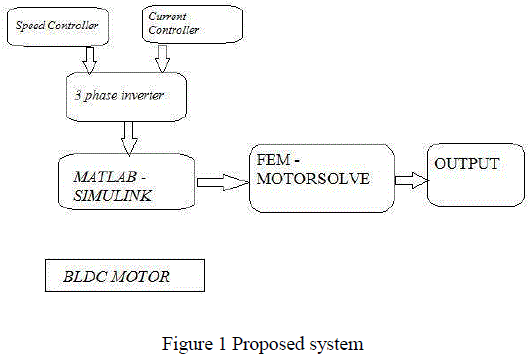 |
| In the proposed method the BLDC motor is designed using MATLAB/SIMULINK and it is integrated with the FEM software for calculating the values of cogging torque in the designed BLDC motor. The design phase of the BLDC motor contains the following blocks such as 1. Speed controller, 2. Current controller, 3. 3- phase inverter. |
| A. Motorsolve- an FEM |
| design software for brushless DC & PMAC machines. MotorSolve BLDC is the highly accurate electric motor design software for brushless DC (BLDC) and permanent magnet AC machines (PMAC) which combines an easy to use template-based interface with an automated-FEA solver. Modern electric motors performance cannot be predicted by general approximations and magnetic circuit calculations. Meeting the growing demand for green & efficient machines requires software that delivers reliable results. Only FEA simulations can |
| Predict performance properly when there is saturation |
| Account for all sources of loss such as eddy current and hysteresis |
| In this FEM we can design our own machine with the specified parameters like the materials to be chosen for the construction of stator, the material for the rotor, number of slots for stator and number of rotor teeth to be designed. Also the design of windings to be used can also be suggested well before the design of the original motor with our parameters and specification. From this FEM we can calculate the performance of the motor very accurately and precisely. The output of the designed motor in the FEM contains the output parameters like BackEMF, cogging torque, torque characteristics etc. Thus this FEM is used for the calculation of the cogging torque in the BLDC motor. |
| B. MATLAB-SIMULINK |
| MATLAB-SIMULINK is very straightforward to represent and then simulate a mathematical model representing a physical system. Models are represented graphically in Simulink as block diagrams. A wide array of blocks is available to the user in provided libraries for representing various phenomena and models in a range of formats. One of the primary advantages of employing Simulink for the analysis of dynamic systems is that it allows us to quickly analyze the response of complicated systems that may be difficult to analyze analytically. The BLDC motor is designed in SIMULINK using various block sets available in the library. The basic design of BLDC motor includes the basic blocks such as control block, state space model and inverter block. The block diagram of the BLDC motor is shown in Figure 2 |
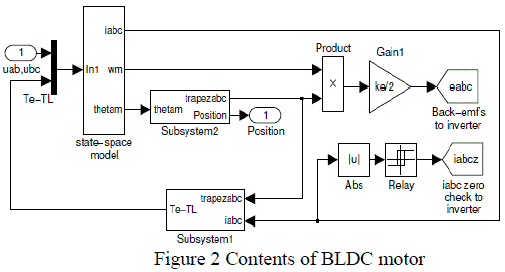 |
| The torque can be calculated using the SIMULINK itself. The block showing the torque calculation is shown in Figure 3 |
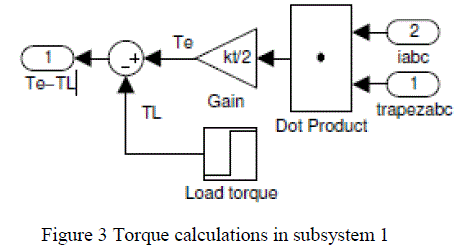 |
IV. EXPERIMENTAL RESULTS |
| The BLDC motor was designed in the Motorsolve FEM to measure the cogging torque value and the BEMF. The simulation showing the design of BLDC motor with the design specifications is shown in the Figure 4. |
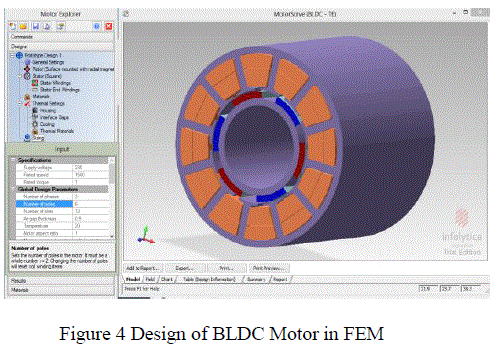 |
| The parameters such as cogging torque , BEMF and current and torque characteristics are studied and shown in the Figure that follows: The cogging torque characteristics for the designed model of the BLDC motor is shown in Figure 5. |
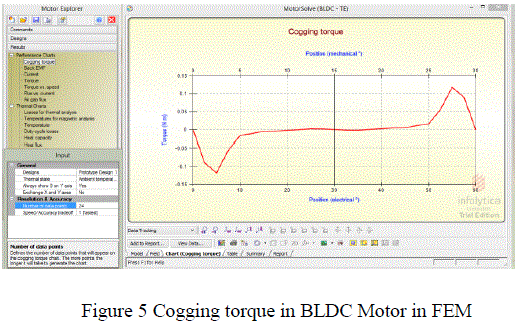 |
| The BEMF characteristic is shown in the following Figure 6. |
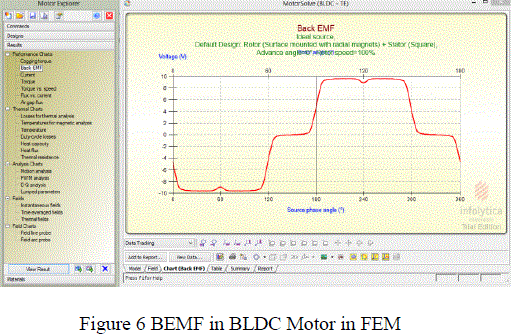 |
| Thus these are some of the experimental results analysed in the FEM. |
V. CONCLUSION |
| This paper presents the computational model for the estimation of Cogging Torque values in the Permanent Magnet Synchronous Motors. The scope of this method is estimation of Cogging Torque is expected to be time saving and efficient, since the use of FEM makes the process easier. The proposed model reduces the Cogging Torque peak values and the torque ripples and harmonics to considerable amount. The further enhancement in this proposed model will be the integration of the FEM design with the MATLAB-SIMULINK. Thus the efficient performance of the motor can be calculated by the reduction of cogging torque and harmonics present. |
References |
|